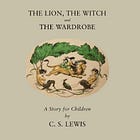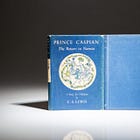The Silver Chair goes beneath Narnia, but what lies beneath The Silver Chair? What works, events, and people contributed to the book? What was C.S. Lewis trying to “sneak past the watchful dragons” of the reader? What can we draw from the books for our own lives?
Welcome to our spring C.S. Lewis read-along. For the next few months, we’ll be going chapter-by-chapter through The Silver Chair. This introduction is open to everyone. The upcoming full chapter discussions will only be available for paid subscribers.
Get to know C.S. Lewis better and read his works more deeply. An annual subscription will take you through this read-along and the following one this fall. Go through The Wardrobe Door as a paid subscriber with this limited-time offer.
The Silver Chair Introduction
One may imagine C.S. Lewis crafting the Narnia stories during relative peace and calm in his life, but that was not the case. The years he spent writing The Chronicles of Narnia, 1948-1954, were some of the most tumultuous of his life.
Severe sickness and exhaustion forced him into the hospital in 1949. The regular Inklings meetings came to an end that same year, removing some of his most constant sources of writing feedback. Mrs. Moore, the mother of a war friend with whom Lewis had a complicated living relationship, faced declining health. She was admitted into a nursing home in 1950 and died in 1951. Lewis’ older brother Warnie often succumbed to alcoholism with stints in rehab.
Professionally, Oxford tasked Lewis with writing the massive English Literature in the Sixteenth Century: Excluding Drama in 1935. He finished the tome in 1954. Still, Lewis was repeatedly passed over for academic promotions and, as a result, carried an extensive teaching load. At a 1948 meeting of the Socratic Club, which Lewis oversaw, Elizabeth Anscombe critiqued Lewis’ Miracles and revealed holes in the reasoning. He revised the entire first chapter in later editions. This played a role in his moving away from public apologetic work.
So how, amid all this turmoil, did Lewis write seven children’s fantasy stories that are still read today? He followed the advice he gave Oxford students during World War II. In the sermon “Learning in War-Time” reprinted in The Weight of Glory, Lewis says:
There are always plenty of rivals to our work. We are always falling in love or quarreling, looking for jobs or fearing to lose them, getting ill and recovering, following public affairs. If we let ourselves, we shall always be waiting for some distraction or other to end before we can really get down to our work. The only people who achieve much are those who want knowledge so badly that they seek it while the conditions are still unfavorable. Favorable conditions never come.
Delivering this sermon in 1939, Lewis could not have known all he would endure in developing his writing. But he recognized then what became pivotal to his work later on: Favorable conditions never come. That was certainly the case for Lewis as he began The Silver Chair.
Work on The Silver Chair
He started in the fall of 1950, around three months after finishing The Horse and His Boy.1 As he did with several other Narnia books, Lewis finished The Silver Chair in a few months. By February 1951, he had a completed manuscript for his friend Roger Lancelyn Green to review.
The Silver Chair, like the first three books, was dedicated to an Inklings members’ child—Nicholas Hardie, son of Colin Hardie, an Oxford classics professor from the end of World War II until his retirement in 1973. He became a regular participant in the Inklings’ meetings. The younger Hardie was around eight at the time of the book’s publishing in 1953.2
Despite The Silver Chair being the fourth book in the series, it is chronologically right before the final book, The Last Battle. In Earth chronology, The Silver Chair happens in the fall immediately following Edmund, Lucy, and Eustace’s adventure that summer in The Voyage of the Dawn Treader.
The five books in the middle of the series—The Lion, the Witch and the Wardrobe, Prince Caspian, The Voyage of the Dawn Treader, The Silver Chair, and The Horse and His Boy—all happen within three Earth years: 1940-1942. In Narnia time, the Dawn Treader’s voyage happens from 2306 to 2307. Eustace returns to Narnia with Jill 50 years later for The Silver Chair.
Inspirations for The Silver Chair
As with each Narnia book, Lewis has numerous allusions to Scripture in The Silver Chair, from Deuteronomy to the Gospels. Lewis also drew on myths of the underworld.3 Lewis loved Virgil’s Aeneid and translated sections of the book, including Aeneas reaching the underworld by ferrying across a river. As with most of the Narnia series, George MacDonald and Shakespeare inspired Lewis. Edmund Spenser’s epic poem The Faerie Queen is an inspiration as well.
Additionally, the book has a poetic, chiastic narrative structure. where it starts on Earth, goes up to Aslan’s country, down to Narnia, down beneath Narnia, back up to Narnia, back up to Aslan’s country, and then back out to Earth.
In his Planet Narnia, Micheal Ward contends each Narnia book corresponds with a planet in the medieval cosmos. The Silver Chair symbolizes the moon. A story centered on discovering and knowing truth, the book also wrestles with lunacy, which comes from the same root word as lunar. The moon was historically connected with wildness and a lack of reason.4
Insights from The Silver Chair
Lewis explained to a young girl in a 1959 letter that the books aren’t allegories but imaginative stories that suppose there was a world like Narnia that needed redemption. What might it look like? “In The Silver Chair, the old king is raised from the dead by a drop of Aslan’s blood.”
In a 1961 letter to Anne Jenkins, Lewis gives a summary of each book as a supposal. He describes The Silver Chair as “the continued war against the powers of darkness.” That may seem like a very sparse description, but when you recognize the central themes of the book, you can see why Lewis used those words. The plot is driven by a focus on remembering and obeying the words of Aslan.
Additionally, in a 1963 letter, Lewis explained that he included Anselm and Descartes’ ontological argument for God’s existence “in a form suitable for children” in the chapter where Puddleglum burns his foot. Good philosophy is used to counteract bad philosophy, but in the end, suffering is necessary to maintain the right perspective.
So, how do we continue the war against the powers of darkness? We remember and obey God’s word. We take care not to be taken captive by philosophy and empty deceit based on human tradition (Colossians 2:8) but instead cultivate and practice God-honoring philosophy and thinking based on eternal truth. Finally, we trust in God’s sovereignty to bring about His good plans, recognizing that the suffering He allows will be for our good and His glory.
That will be our guide as we go above, through and under Narnia in The Silver Chair.
Next time: Chapter 1, “Behind the Gym”
Further up and further in
Resources used:
The Silver Chair — C.S. Lewis
The Lion, the Witch and the Wardrobe — C.S. Lewis
Prince Caspian — C.S. Lewis
The Voyage of the Dawn Treader — C.S. Lewis
The Horse and His Boy — C.S. Lewis
The Magician’s Nephew — C.S. Lewis
The Last Battle — C.S. Lewis
The Weight of Glory — C.S. Lewis
The Problem of Pain — C.S. Lewis
Miracles — C.S. Lewis
On Stories and Other Essays on Literature — C.S. Lewis
Of Other Worlds: Essays and Stories — C.S. Lewis
God in the Dock — C.S. Lewis essays, edited by Walter Hooper
English Literature in the Sixteenth Century — C.S. Lewis
The Collected Letters of C.S. Lewis, Volume 3: Narnia, Cambridge, and Joy, 1950-1963 — Editor: Walter Hooper
C.S. Lewis: The Companion and Guide — Walter Hooper
Past Watchful Dragons: The Origin, Interpretation, and Appreciation of the Chronicles of Narnia — Walter Hooper
Companion to Narnia: A Complete Guide to the Magical World of C.S. Lewis’ The Chronicles of Narnia — Paul Ford
Into the Wardrobe: C.S. Lewis and the Narnia Chronicles — David C. Downing
Planet Narnia: The Seven Heavens in the Imagination of C.S. Lewis — Michael Ward
The Narnia Code: C.S. Lewis and the Secret of the Seven Heavens — Michael Ward
The C.S. Lewis Readers’ Encyclopedia — Editors: Jeffrey Schultz, John G. West, Jr.
The Making of C.S. Lewis: From Atheist to Apologist (1918-1945) — Harry Lee Poe
The Completion of C.S. Lewis: From War to Joy (1945-1963) — Harry Lee Poe
C.S. Lewis: A Life — Alister McGrath
Wade Center Podcast “Into Narnia, Vol. 4, The Voyage of the Dawn Treader” — Marion E. Wade Center, Wheaton College
The C.S. Lewis Podcast with Alister McGrath “#28 The Voyage of the Dawn Treader” — Premiere Insights
The Faerie Queene — Edmund Spencer
The Aeneid — Virgil
If you’d like to catch up on previous read-alongs, you can see the full collection of articles from the previous three Narnia books. I’ve unlocked each of these conclusion posts for everyone, but only paid subscribers will have full access to all the chapter-specific articles.
If you’re wondering why The Silver Chair is numbered “Book 6” by the publishers but we’re reading it fourth, you can read these two explanations for the correct reading order.
Though The Horse and His Boy was finished before The Silver Chair, the latter was published first.
For Christmas in 1950, Lewis gave him an autographed copy of The Lion, the Witch and the Wardrobe, which read, “Nicholas Hardie, with love from Jack Lewis.” The book was bought at auction around 13 years ago for what would be $61,500 today.
One of the other titles Lewis suggested was “Night Under Narnia.”
I find Ward’s argument persuasive if not fully convincing. If you are interested, I’d suggest Planet Narnia for the fully scholarly work or The Narnia Code for those wanting a shorter book geared more toward the layperson.












The Silver Chair seems to be a child's version of That Hideous Strength.
I'm looking forward to the read-along!